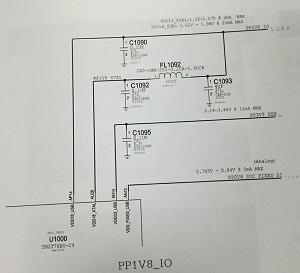We ever repaired an iPhone X which has the same fault with this one. So we still start the same first step: test <PP_VDD_MAIN,PP_VDD_BOOST,PP1V8,PP1V1_S2,PP0V8_SOC_FIXED_S1,PP1V8_S2> With the DC power supply.
After we get the data,we found PP1V1_S2,PP0V8_SOC_FIXED_S1,PP1V8_S2 jumps constantly, so we doubt this may be caused by a power supply circuit of U2700 output. We measured it with digital multimeter, there no other fault appears, it means we should take some other way to diagnosis it.
We repaired iPhone 7P before and know that if crystal oscillator is false welding can also cause voltage jumping, And if iPhone CPU power supply is abnormal also can cause voltage jumping. Check the crystal oscillator we find no problem, then check the CPU power supply! As shown in iPhone schemtic diagram 14-3-1 and 14-3-2, there are three ways of power supply, not only directly into the CPU, but also through the small resistance or inductance into the CPU, the three voltage are PP1V2_SOC, PP0V8_SOC_FIXED_S1, PP1V8_IO.
14-3-1
14-3-2
Testing the 3 power supply one by one, when the FL1092 inductor of PP1V8_IO is measured, one end is 1.8V while the other end is 0V.
14-3-3
Testing the end without voltage to the ground dipole value is 490, the normal is about 280. Then testing the inductor's noumenon value is very large, indicating the iPhone X inductor is damaged, so we replace a new inductor, the fault is repaired well.
Later, it was analyzed that the PP1V8_IO was renamed as PP1V8_XTAL after inductance FL1092, which was supplied to the CPU crystal module. It also verified that the voltage jump of iPhone X and the voltage jump of 7P before were actually the same thing.
Hope this iPhone X repair case will help you.



No comments:
Post a Comment